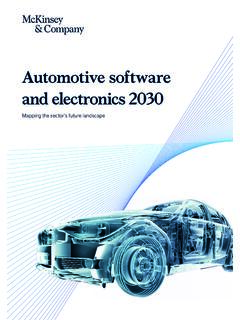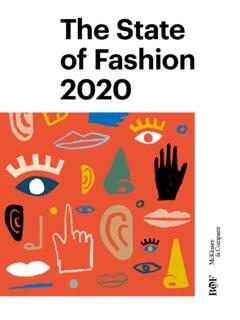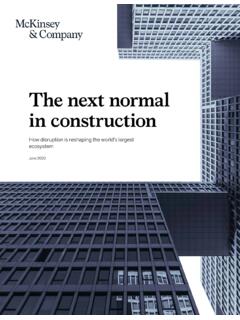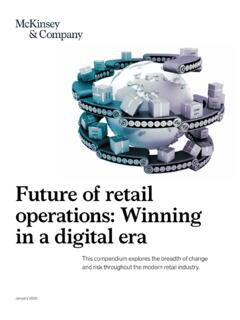Transcription of Leveraging Industrial IoT and advanced technologies for ...
1 Leveraging Industrial IoT and advanced technologies for digital transformation How to align business, organization, and technology to capture value at scaleby Andreas Behrendt, Enno de Boer, Tarek Kasah, Bodo Koerber, Niko Mohr, and G rard Richter3 PrefaceThe set of advanced technologies in the manufacturing space is comprised of many digital innovations: advanced analytics, automation, the Industrial Internet of Things (IIoT), Industry , machine learning, artificial intelligence (AI), cloud platforms, and so on. These innovations have the potential to boost the productivity of companies legacy operations. For incumbent companies, these advanced technologies support the creation of all-new, digitally enabled business models and help increase operational efficiencies and the customer experience in production and logistics. Manufacturing enterprises that want to modernize cannot ignore these benefits; several large organizations in this space are already working with these technologies , at least to some the digital technologies listed above, IIoT or Industry , terms used interchangeably in this report, are of particular relevance to manufacturing.
2 Yet while many manufacturing organizations are piloting digital initiatives, very few have managed to scale their IIoT-enabled use cases in a way that achieves significant operational or financial benefits. One of the reasons for this pilot trap is probably that IIoT is often regarded primarily as a technical implementation challenge, with the drive for adoption spearheaded by specialists in information technology (IT) and operational technology (OT) functions. Yet time and again, it becomes apparent that deriving real business gains from IIoT efforts requires top management to create the conditions in which processes across the business can be changed, paving the way for wide-scale, sustainable value creation. For example, connecting production equipment to the internet will allow a company to reduce downtime through analytics-enabled asset productivity optimization, but if the surrounding business processes aren t modified and also optimized, the value is limited to that particular area.
3 In order to maximize IIoT s value, people and processes must also shift to capture the benefits of those data-driven insights by receiving insights in real time to react faster or by gaining better information to drive more targeted action. This requires the commitment of leadership to ensure that IIoT is not just an IT initiative but an organization-wide effort. Technical obstacles to IIoT at scale exist, too. Many organizations are still wondering, for example, how to overcome the challenges caused by heterogeneous system and application landscapes, or how to analyze which functions should be supported by which systems (for example, product life-cycle management, enterprise resource planning, manufacturing execution, supply-chain management). There is also the question of where those systems should be deployed on the edge, at the manufacturing site, or in the cloud a question that relates to the governance between IT and OT and considers latency and security necessities.
4 Because of these complexities, even companies with a good IIoT track record can be expected to face challenges if they do it alone. Technical IIoT ecosystems are growing and improving by the day. In many cases, collaboration often with players that have high levels of expertise in areas such as analytics, IIoT, and cloud platforms within the Industrial software stack can be a competitive advantage. Beyond the necessity of collaboration, the complexity of the emerging ecosystems prompts questions concerning investment, leadership, and governance. Mastering these complexities requires overcoming the integration challenge between business operations, organization, and technology. In this report, we offer guideposts for driving digital transformations by successfully aligning the business, organization, and technology spheres to help manufacturing and technology leaders successfully navigate the IIoT landscape and position their organizations to reap the full set of its benefits.
5 4 ContentsIntroduction 6 Part A: Industry trends for a promising perspective on digital manufacturing 111 A brief outline of technological and impact-related developments in the digital manufacturing space Technology trends are rather promising Leveraging an IIoT-enabled backbone, the plants in the Global Lighthouse Network achieve significant results in their performance metrics 132 Manufacturing companies should continue to commit to digital innovation, and reassess their digital initiatives 17 Part B: A framework for success in IIoT-based value capture at scale 211 Business (Manufacturing) Use- case identification and prioritization 25 Step 1: Generate a comprehensive list of use cases in a combined top-down and bottom-up manner 25 Step 2: Catalog, qualify, and prioritize use cases 25 Step 3: Set up lighthouse cases for master blueprints Plant rollout and enablement 28 Step 1: Set up a rollout that is value driven and pursues impact 28 Step 2: Start gathering and aggregating data, conducting important activities in parallel 30 Step 3: Establish the processes and collaboration that enable the required rollout 312 Organization Value capture: Change and performance management 32 Step 1: Define an overall road map of the IIoT transformation and use- case target values 32 Step 2: Set up a value-capture organization, model, and mechanism 32 Step 3: Implement consistent deviation management Capability building and a new way of working 33 Step 1.
6 Establish structural organizational changes and implement new governance and a new way of working 33 Step 2: Identify and fill the skills gap 36 Step 3: Manage role transitions and implement a change process to support a mindset shift across hierarchy levels 3753 Technology IIoT and data infrastructure: Core platform design (including IT-OT cybersecurity) 40 Step 1: Fully assess the current brownfield setup in both OT and IT 46 Step 2: Create the future target architecture to enable the use case 48 Step 3: Effectively manage cybersecurity challenges in IT-OT convergence 55 Step 4: Select a partner rather than a vendor to help implement the platform IIoT platform: The cloud imperative in manufacturing 59 Step 1: Make the cloud pay off in the short term 62 Step 2: Tightly manage and control the cloud transformation 62 Step 3: Set up an infrastructure team that can operate much like an app development team Tech ecosystem 64 Step 1: Understand the key elements of a sustainable ecosystem 65 Step 2: Choose the right partners, with a view to achieving balanced partner diversity for the platform-enabled ecosystem 65 Step 3: Implement business development teams as a structure to manage the complex ecosystem and ensure agility 67 Outlook: How to get started on a digital transformation in manufacturing 68 Glossary 69 Authors 74 6 Introduction Innovations in the Industrial software stack, along with applications for advanced analytics, AI, machine learning, 5G connectivity, edge computing, and the Industrial Internet of Things (IIoT), are potentially valuable assets for manufacturers.
7 For many manufacturing companies, however, tech selection may be the easy part; capturing value and scaling up impactful use cases is where the challenge lies. Use cases need to be digitally enabled, but heterogeneous system and application landscapes could be a roadblock deriving from legacy software , organic growth, merger and acquisition activities, and/or decentralized sourcing decisions for solutions and technologies . These technical challenges, in combination with the hurdles of an unclear business plan and insufficient organizational capabilities, end up trapping many companies in an ongoing pilot purgatory. In recent years, technology has made tremendous improvements, especially in the field of scalable connectivity and integration, which finally enables manufacturing companies to both wrap and extend their existing solutions, rather than rip and replace them.
8 If used prudently, these technologies allow companies to implement and scale impactful use cases at minimal incremental cost. In our research and field work, we have observed that Industrial manufacturers that take an integrated approach are the most successful. These companies capture the business value of Industrial digitization across the value chain, including for their suppliers and customers. From the start of the transformation, they see the importance of the enormous shifts required in organization and technology, which need to be thought through beyond single functions. This report focuses on digital manufacturing as well as the underlying organizational and technological changes to support it (Exhibit 1) .The goal of this report is to provide deep and ready-to-use insights into the various issues raised by the influx of new technologies as business enablers, and how to successfully capture value and scale use cases in manufacturing.
9 McKinsey s IoT and manufacturing group has launched a research effort to understand the key enablers behind this IIoT-based value capture at scale, and the results are summarized in this report. It provides reasons why companies should continue to leverage IIoT-enabled technology, as well as ready-to-use guidance on how they can do so. The report draws on knowledge from our extensive field work, augmented with the latest McKinsey research and insights from respected sources, including: McKinsey studies in partnership with the World Economic Forum, including 54 lighthouses in digital manufacturing1 Experience from major, impactful client studies with leading manufacturing companies on IIoT, analytics, and cloud-enabled transformations, which leverage the latest technologies in connectivity, data architecture, and edge computing Key lessons from successful digital and data-driven transformations, with a special focus on skills transformation, capability building, and change management McKinsey research and in-depth exchanges with leading academic institutions, industry associations, and industry surveys This report is not just for IT, OT, and digital executives in the manufacturing environment.
10 It is also relevant for leaders across a variety of functions and areas, including operations, supply chain, process engineering, and World Economic Forum and McKinsey & Company, Global Lighthouse Network: Four durable shifts for a great reset in manufacturing, World Economic Forum, September 2020, costsCapitalizing on the Industrial Internet of Things requires an int egrated approach fo r dri vi ng end-to-end transformation across business, organization, and : McKinsey Digital Transformation ServicesExhibit 1 OrganizationFoster the mindset and behavioral changes required to operate in a digitized environment and sustain the transformationChange management: The heart Create nancial transparency and pro t-and-loss-linked value drivers so improvements on the ground translate to nancial gainFinancial transparency: The eye Use a relentless cadence to ensure superior execution and value delivery to the bottom line, driving nancial initiatives, objectives, and key resultsPerformance infrastructure: The brain Build on agile principles to organize, operate, innovate, and transform in a cross-functional and iterative mannerAgile organization: The yogi Reskill the current organization across leadership, functional, digital, and transformation capabilitiesDigital capability building.
















